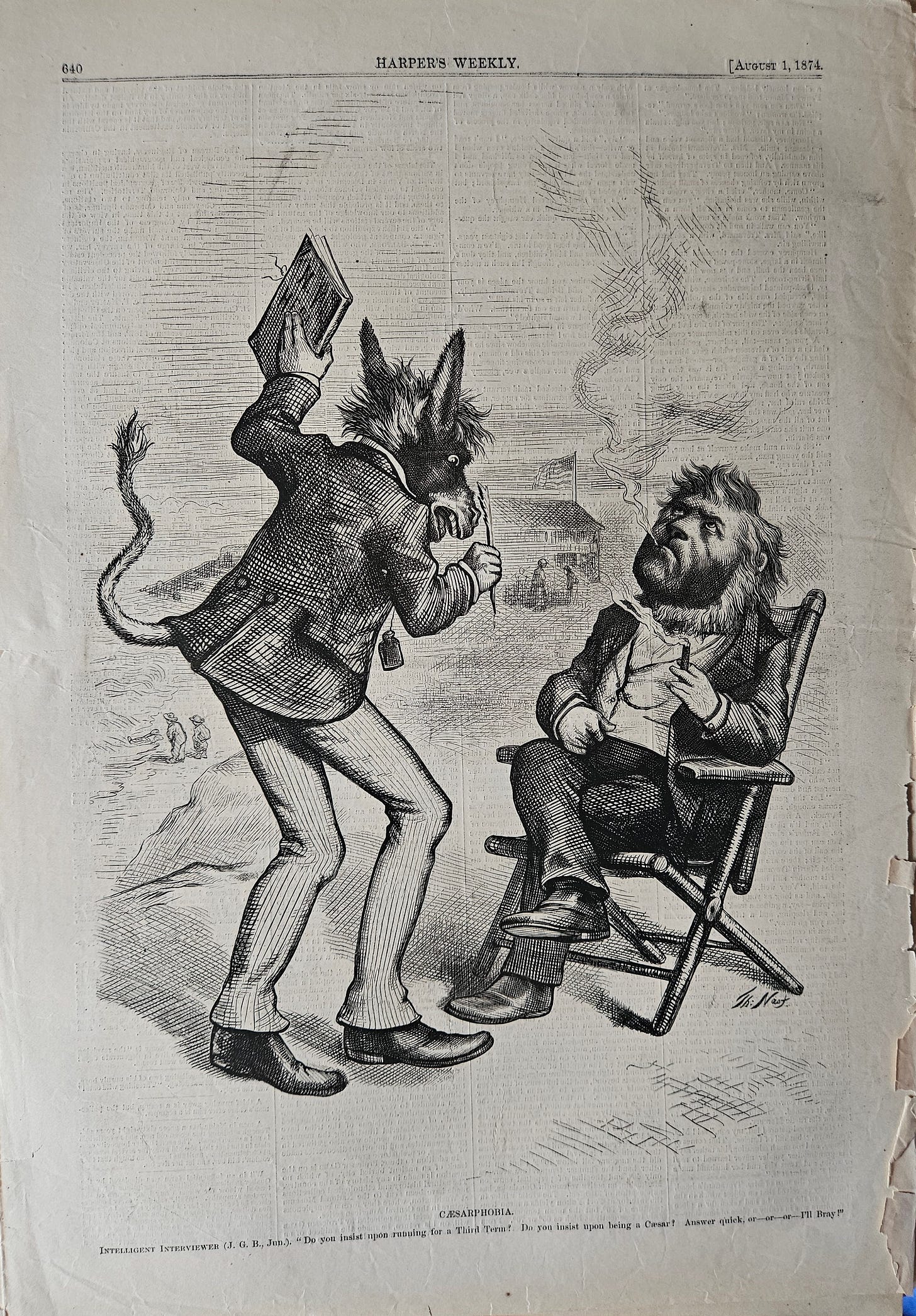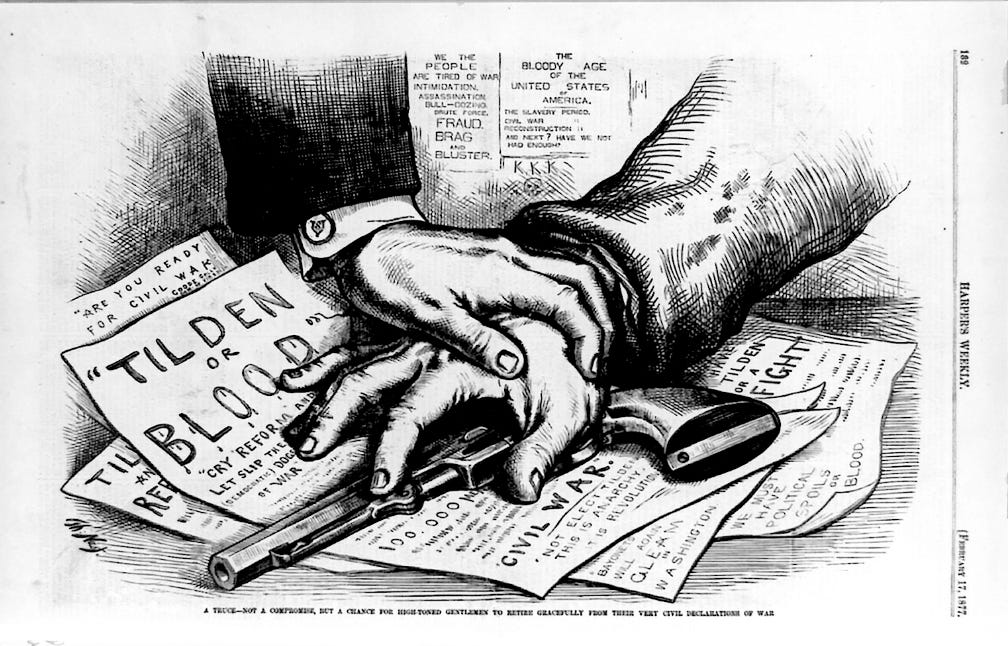“CAESARPHOBIA.” President Grant had ultimately refused to run for for a 3rd term, opening the door for Rutherford B. Hayes, who won in a horribly contested race with Samuel J. Tilden (*remember Gore?.
Titled: "CAESARPHOBIA/INTELLIGENT INTERVIEWER (J. G. B. JUN.) DO YOU INSIST UPON RUNNING FOR A THIRD TERM? DO YOU INSIST UPON BEING A CEASAR? ANSWER QUICK, OR I'LL BRAY!"
The cartoon image mocks new paper publisher James Gordon Bennett Jr. (As the Democratic Donkey) throwing a fit over the possibility of President Grant (with lion mane…) seeking a 3rd term in 1876. Nast was a strong supporter of Grant & a hater of Bennett whose "New York Herald" was a competitor of Nast's "Harper Weekly." Worst, Bennett supported those demons of Hell, the Democrats. (from InValuable)
———-
President Grant had ultimately decided not to run for for a 3rd term, opening the door for Rutherford B. Hayes. Gore
It was widely assumed during the year 1875 that incumbent President Ulysses S. Grant would run for a third term as president despite the poor economic conditions, the numerous political scandals that had developed since he assumed office in 1869, and despite a longstanding tradition set by George Washington not to stay in office for more than two terms. Grant's inner circle advised him to go for a third term and he almost did so, but on December 15, 1875, the House, by a sweeping 233–18 vote, passed a resolution declaring that the two-term tradition was to prevent a dictatorship.[6]
THE COMPROMISE OF 1877 (Info from Wikipedia)
The 1876 United States presidential election was the 23rd quadrennial presidential election, held on Tuesday, November 7, 1876. Incumbent Republican president Ulysses S. Grant declined to run for a third term, so the party chose Rutherford B. Hayes, the governor of Ohio, as its nominee.
The Democratic Party nominated New York governor Samuel J. Tilden as their nominee. It was one of the most contentious presidential elections in American history. Its resolution involved negotiations between the Republicans and Democrats, resulting in the Compromise of 1877, and on March 2, 1877, the counting of electoral votes by the House and Senate occurred, confirming Hayes as president.
Tilden, who had prosecuted machine politicians in New York and sent the legendary political boss William M. Tweed to jail, ran as a reform candidate against the background of the corruption of the Grant administration.
Both parties backed civil service reform. Both sides mounted mudslinging campaigns, with Democratic attacks on Republican corruption being countered by Republicans raising the Civil War issue, a tactic that was ridiculed by Democrats, who called it "waving the bloody shirt." Republicans chanted, "Not every Democrat was a rebel, but every rebel was a Democrat."
It was the second of five U.S. presidential elections in which the winner did not win a plurality of the national popular vote. This is the first time it happened since 1824.
Following President Grant's decision to retire after his second term, U.S. Representative James G. Blaine emerged as the frontrunner for the Republican nomination. However, Blaine was unable to win a majority at the 1876 Republican National Convention, which settled on Governor Hayes of Ohio as a compromise candidate. The 1876 Democratic National Convention nominated Governor Tilden of New York on the second ballot.
Although Tilden indisputably beat Hayes in the popular vote, there were wide allegations of electoral fraud, election violence, and disfranchisement of (predominantly Republican) black voters.
After a first count of votes, Tilden won 184 electoral votes to Hayes's 165 with 20 votes from Florida, Louisiana, South Carolina, and Oregon unresolved. To address the resulting constitutional crisis, Congress established the Electoral Commission, a majority of which were Republicans, which awarded all twenty votes (and thus the presidency) to Hayes.
(Remember Al Gore, 2000 election?)
Hayes was a virtual unknown outside his home state of Ohio, where he had served two terms as a US Representative and then two terms as governor. Henry Adams called Hayes "a third-rate nonentity whose only recommendations are that he is obnoxious to no one." Hayes had served in the Civil War with distinction as colonel of the 23rd Ohio Regiment and was wounded several times, which made him marketable to veterans. He had later been brevetted as a major-general. His most important asset was his help to the Republican ticket in carrying Ohio, a crucial swing state. On the other side, the newspaperman John D. Defrees described Tilden as "a very nice, prim, little, withered-up, fidgety old bachelor, about one-hundred and twenty-pounds avoirdupois, who never had a genuine impulse for many nor any affection for woman."[15]
———-
Some Democratic representatives filibustered the commission's decision, hoping to prevent Hayes's inauguration, but their filibuster was ultimately ended by party leader Samuel J. Randall. The question of who should have been awarded those electoral votes is the source of the continued controversy.
To date, it remains the election that yielded the highest voter turnout of the eligible voting-age population in American history, at 82.6%.[2][3] Tilden's 50.9% is the largest share of the popular vote received by a candidate who was not elected to the presidency, marking the only presidential election in U.S. history in which the losing candidate won a majority of the vote. Tilden was also the last person to win a majority of the popular vote until William McKinley in 1896.
As of 2024, this marks the only presidential election in which both candidates were sitting governors. This is also the only presidential election where the winning candidate won the exact number of electoral votes needed to win at the time. (185).————
"A truce – not a compromise, but a chance for high-toned gentlemen to retire gracefully from their very civil declarations of war." By Thomas Nast in Harper's Weekly, 1877 Feb 17







Back in a time when I could imagine myself admiring someone (Nast) even though he was a Republican. Hard to imagine these days.